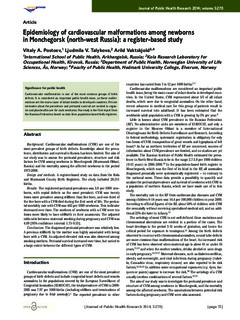Epidemiology of cardiovascular malformations among newborns in Monchegorsk (north-west Russia): a register-based study
Journal article, Peer reviewed
Permanent lenke
http://hdl.handle.net/11250/226259Utgivelsesdato
2014Metadata
Vis full innførselSamlinger
Originalversjon
Postoev, V.A., Talykova, L. & Vaktskjold, A. (2014). Epidemiology of cardiovascular malformations among newborns in Monchegorsk (north-west Russia): a register-based study. Journal of Public Health Research, 3:270. doi: http://dx.doi.org/10.4081/jphr.2014.270 http://dx.doi.org/10.4081/jphr.2014.270Sammendrag
Background. Cardiovascular malformations (CVM) are one of the
most prevalent groups of birth defects. Knowledge about the prevalence,
distribution and survival in Russia has been limited. The aim of
our study was to assess the perinatal prevalence, structure and risk
factors for CVM among newborns in Monchegorsk (Murmansk Oblast,
Russia) and the mortality among the affected newborns in the period
1973-2008.
Design and methods. A register-based study on data from the Kola
and Murmansk County Birth Registers. The study included 28,511
births.
Results. The registered perinatal prevalence was 3.0 per 1000 newborns,
with septal defects as the most prevalent. CVM was twenty
times more prevalent among stillborn than live born, and one-third of
the live born with a CVM died during the first week of life. The perinatal
mortality rate with CVM was 442 per 1000 newborns. This indicator
decreased over time. The mothers of newborns with a CVM were ten
times more likely to have stillbirth in their anamnesis. The adjusted
odds ratio between maternal smoking during pregnancy and CVM was
4.09 [95% confidence interval: 1.75-9.53].
Conclusions. The diagnosed perinatal prevalence was relatively low.
A previous stillbirth by the mother was highly associated with being
born with a CVM. An adjusted elevated risk was also observed among
smoking mothers. Perinatal survival increased over time, but varied to
a large extent between the different types of CVM.
Beskrivelse
This is an Open Access article licensed under a Creative Commons Attribution NonCommercial 3.0 License (CC BY-NC 3.0) and originally published in Journal of Public Health Research. You can access the article by following this link: http://dx.doi.org/10.4081/jphr.2014.270.
